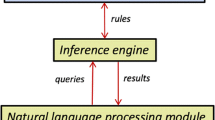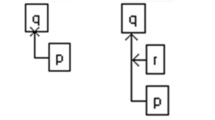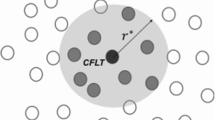Abstract
The BankXX system models the process of perusing and gathering information for argument as a heuristic best-first search for relevant cases, theories, and other domain-specific information. As BankXX searches its heterogeneous and highly interconnected network of domain knowledge, information is incrementally analyzed and amalgamated into a dozen desirable ingredients for argument (called argument pieces), such as citations to cases, applications of legal theories, and references to prototypical factual scenarios. At the conclusion of the search, BankXX outputs the set of argument pieces filled with harvested material relevant to the input problem situation.
This research explores the appropriateness of the search paradigm as a framework for harvesting and mining information needed to make legal arguments. In this article, we describe how legal research fits the heuristic search framework and detail how this model is used in BankXX. We describe the BankXX program with emphasis on its representation of legal knowledge and legal argument. We describe the heuristic search mechanism and evaluation functions that drive the program. We give an extended example of the processing of BankXX on the facts of an actual legal case in BankXX's application domain — the good faith question of Chapter 13 personal bankruptcy law. We discuss closely related research on legal knowledge representation and retrieval and the use of search for case retrieval or tasks related to argument creation. Finally we review what we believe are the contributions of this research to the understanding of the diverse disciplines it addresses.
Similar content being viewed by others
References
Alvarado, S. J. (1990). Understanding Editorial Text: A Computer Model of Argument Comprehension. Boston, MA: Kluwer Academic Publishers.
Ashley, K. D. (1990). Modeling Legal Argument: Reasoning with Cases and Hypotheticals. Cambridge, MA: M.I.T. Press.
Ashley, K. D. & Aleven, V. (1991). A Computational Approach to Explaining Case-Based Concepts of Relevance in a Tutorial Context. Proceedings Case-Based Reasoning Workshop 1991, 257–268. Washington, D.C. Morgan Kaufmann, San Mateo, CA.
Ashley, K. D. & Rissland, E. L. (1987). But, See, Accord: Generating Blue Book Citations in HYPO. Proceedings First International Conference on AI and Law (ICAIL-87), 67–74. Boston, MA. Association for Computing Machinery.
Barr, A., Feigenbaum, E. A. & Cohen, P. (1981). The Handbook of Artificial Intelligence. Reading, MA: Addison-Wesley.
Berman, D. H. & Hafner, C. D. (1991). Incorporating Procedural Context into a Model of Case-Based Legal Reasoning. Proceedings Third International Conference on Artificial Intelligence and Law (ICAIL-91), 12–20. Oxford, England. Association for Computing Machinery.
Bhatnagar, R. K. (1989). Construction of Preferred Causal Hypotheses for Reasoning with Uncertain Knowledge. Ph.D. Dissertation, University of Maryland, College Park, MD.
Bhatnagar, R. & Kanal, L. N. (1991). A Formalism for Automated Generation of Preferred Arguments. Working Notes, AAAI Spring Symposium Series, Argument and Belief, 39–61. Palo Alto, CA.
Bing, J. (1987). Designing Text Retrieval Systems for “Conceptual Searching.” Proceedings First International Conference on Artificial Intelligence and Law (ICAIL-87), 43–51. Boston, MA. Association for Computing Machinery.
Bluebook. (1986). A Uniform System of Citation (14th ed.). Cambridge, MA: The Harvard Law Review Association.
Branting, L. K. (1991). Building Explanations from Rules and Structured Cases. International Journal of Man-Machine Studies, 34, 797–837.
Croft, W.B. (1979). Organizing and Searching Large Files of Document Descriptions. Ph.D. Dissertation, University of Cambridge, England.
Dasarathy, B. V. (1991). Nearest Neighbor (NN) Norms: NN Pattern Classification Techniques. Los Alamitos, CA: IEEE Computer Society Press.
Dick, J. P. (1987). Conceptual Retrieval and Case Law. Proceedings First International Conference on AI and Law (ICAIL-87), 106–115. Boston, MA. Association for Computing Machinery.
Fikes, R. E., Hart, P., & Nilsson, N. J. (1972). Learning and executing generalized robot plans. Artificial Intelligence. 3:251–288.
Gardner, A. vdl. (1987). An Artificial Intelligence Approach to Legal Reasoning. M.I.T. Press, Cambridge.
Gelbart, D. and Smith, J.C. (1991). Beyond Boolean Search: FLEXICON, A Legal Text-Based Intelligent System. Third International Conference on Artificial Intelligence and Law (ICAIL91), 225–234. Oxford, England. Association for Computing Machinery.
Gordon, T. F. (1991). An Abductive Theory of Legal Issues. International Journal of Man-Machine Studies. 35:95–118.
Hafner, C. D. (1981). An Information Retrieval System Based on a Computer Model of Legal Knowledge. Ph.D. thesis, University of Michigan, republished by UMI Research Press, Ann Arbor, MI.
Hafner, C. D. (1987). Conceptual Organization of Case Law Knowledge Bases. Proceedings First International Conference on Artificial Intelligence and Law, 35–42. Boston, MA. Association for Computing Machinery.
Hammond, K. J. (1989). Case-Based Planning: Viewing Planning as a Memory Task. Boston, MA: Academic Press.
Kolodner, J. L. (1983). Maintaining Organization in a Dynamic Long-Term Memory. Cognitive Science, 7(4), 243–280.
Kunz, C. L., Schmedemann, D. A., Bateson, A. L., Downs, M. P. & Erlinder, C. P. (1992). The Process of Legal Research (Third Edition ed.). Boston, MA: Little, Brown.
Lakoff, G. (1987). Women, Fire, and Dangerous Things: What Categories Reveal about the Mind. Chicago, IL: University of Chicago Press.
Lehnert, W. G. (1981). Plot units and Narrative Summarization. Cognitive Science, 5(4): 293–331.
Levi, E. H. (1949). An Introduction to Legal Reasoning. Chicago, IL: University of Chicago Press.
Loui, R. P., Norman, J., Olson, J., & Merrill, A. (1993). A Design for Reasoning with Policies, Precedents, and Rationales. Proceedings Fourth International Conference on Artificial Intelligence and Law (ICAIL-93), 202–211. Amsterdam, The Netherlands. Association for Computing Machinery.
McCarty, L. T., & Sridharan, N. S. (1982). A Computational Theory of Legal Argument. Technical Report LRP-TR-13. Laboratory for Computer Science, Rutgers University.
Minton, S. (1988). Learning Effective Search Control Knowledge: An Explanation-Based Approach. Boston, MA: Kluwer Academic Publishers.
Nilsson, N. J. (1990). The Mathematical Foundations of Learning Machines. San Mateo, CA: Morgan Kaufmann.
Perelman, C. & Olbrechts-Tyteca, L. (1969). The New Rhetoric: A Treatise on Argumentation. Notre Dame, Indiana: University of Notre Dame Press.
Porter, B. W., Bareiss, R. & Holte, R. C. (1990). Concept Learning and Heuristic Classification in Weak-Theory Domains. Artificial Intelligence, 45, 229–263.
Prakken, H. (1993). Logical Tools for Modelling Legal Argument. Ph. D. Dissertation, Vrije Universiteit, Amsterdam.
Rissland, E. L. (1977). Epistemology, Representation, Understanding and Interactive Exploration of Mathematical Theories. Ph.D. Dissertation. MIT, 1977.
Rissland, E. L. (1978). Understanding Understanding Mathematics. Cognitive Science, 2, 361–383.
Rissland, E. L. (1980). Example Generation. Proceedings Third National Conference of the Canadian Society for Computational Studies of Intelligence, Victoria, BC.
Rissland, E. L., Daniels, J. J., Rubinstein, Z. B. & Skalak, D. B. (1993). Case-Based Diagnostic Analysis in a Blackboard Architecture. Proceedings of the Eleventh National Conference on Artificial Intelligence (AAAI-93), 66–72. Washington, DC. AAAI Press/MIT Press.
Rissland, E. L. & Skalak, D. B. (1991). CABARET: Rule Interpretation in a Hybrid Architecture. International Journal of Man-Machine Studies, 34, 839–887.
Rissland, E. L., Skalak, D. B. & Friedman, M. T. (1993a). Case Retrieval through Multiple Indexing and Heuristic Search. Proceedings of Thirteenth International Joint Conference on Artificial Intelligence (IJCAI-93), Chambery, Savoie, France. International Joint Conferences on Artificial Intelligence.
Rissland, E. L., Skalak, D. B. & Friedman, M. T. (1993b). BankXX: A Program to Generate Argument through Case-Based Search. Proceedings Fourth International Conference on Artificial Intelligence and Law (ICAIL-93), 117–124, Amsterdam, The Netherlands. Association for Computing Machinery.
Rissland, E.L., Skalak, D.B. & Friedman, M.T. (1995). Evaluating a Legal Argument Program: The BankXX Experiments. To appear in The Journal of Artificial Intelligence and Law. Also available as Technical Report, CMPSCI TR 95–30, Department of Computer Science, University of Massachusetts, Amherst, MA.
Rissland, E. L., Valcarce, E. M. & Ashley, K. D. (1984). Explaining and Arguing with Examples. Proceedings of the National Conference on Artificial Intelligence (AAAI-84), 288–294. Austin, TX. American Association for Artificial Intelligence.
Rosch, E. & Mervis, C. B. (1975). Family Resemblances: Studies in the Internal Structure of Categories. Cognitive Psychology, 7, 573–605.
Rose, D. E. & Belew, R. K. (1991). A Connectionist and Symbolic Hybrid for Improving Legal Research. International Journal of Man-Machine Studies, 35, 1–33.
Rose, D. E. (1994). A Symbolic and Connectionist Approach to Legal Information Retrieval. Lawrence Erlbaum, Hillsdale, N.J.
Salton, G. (1989). Automatic Text Processing. Reading, MA: Addison-Wesley.
Samuel, A. L. (1959). Some studies in machine learning using the game of checkers. IBMJ. Research and Development, 3:210–229.
Samuel, A. L. (1967). Some studies in machine learning using the game of checkers. II — Recent Progress. IBM J. Research and Development, 11:601–617.
Schank, R. C. (1982). Dynamic Memory, Cambridge: Cambridge University Press.
Schank, R. C. (1990). Tell Me a Story: A New Look at Real and Artificial Memory. New York, NY: Scribner.
Shepard's. (1994). Shepard's Federal Citations. Colorado Springs, CO: Shepard's/McGraw-Hill.
Skalak, D. B. (1994). Prototype and Feature Selection by Sampling and Random Mutation Hill Climbing Algorithms. Proceedings of the Eleventh International Conference on Machine Learning. New Brunswick, NJ. Morgan Kaufmann.
Skalak, D. B. & Rissland, E. L. (1992). Arguments and Cases: An Inevitable Intertwining. Artificial Intelligence and Law: An International Journal, 1(1), 3–48.
Sullivan, T. A., Warren, E. & Westbrook, J. L. (1989). As We Forgive Our Debtors. New York, NY: Oxford University Press.
Sycara, K. P. (1989). Argumentation: Planning Other Agents' Plans. Proceedings Eleventh International Joint Conference on Artificial Intelligence (IJCAI-88), 517–523. Detroit, MI.
Sycara, K. P. & Navinchandra, D. (1991). Influences: A Thematic Abstraction for Creative Use of Multiple Cases. Proceedings Case-Based Reasoning Workshop 1991, 133–144. Washington, DC. San Mateo, CA: Morgan Kaufmann.
Toulmin, S. (1958). The Uses ofArgument. Cambridge University Press.
Twining, W. & Miers, D. (1991). How To Do Things With Rules. London: Weidenfeld and Nicolson.
Turner, R. (1988). Organizing and Using Schematic Knowledge for Medical Diagnosis. Proceedings Case-Based Reasoning Workshop 1988, 435–446. Clearwater Beach, FL. San Mateo, CA: Morgan Kaufmann.
Utgoff, P. E., & Clouse, J. A. (1991). Two kinds of training information for evaluation function learning. Proceedings Ninth National Conference on Artificial Intelligence (AAAI-91), 596–600. Anaheim, CA. MIT Press.
Voorhees, E.M. (1985). The Effectiveness and Efficiency of Agglomerative Clustering in Document Retrieval. Ph.D. Dissertation, Cornell University, Ithaca, NY
West (1992). WestLaw. St. Paul, MN: West Publishing Co.
Words and Phrases (1994). Words and Phrases. St. Paul, MN: West Publishing.
Author information
Authors and Affiliations
Additional information
This research was supported in part by grant No. 90-0359 from the Air Force Office of Sponsored Research and NSF grant No. EEC-9209623 State/University/Industry Cooperative Research on Intelligent Information Retrieval.
Rights and permissions
About this article
Cite this article
Rissland, E.L., Skalak, D.B. & Friedman, M.T. BankXX: Supporting legal arguments through heuristic retrieval. Artif Intell Law 4, 1–71 (1996). https://doi.org/10.1007/BF00123994
Issue Date:
DOI: https://doi.org/10.1007/BF00123994




